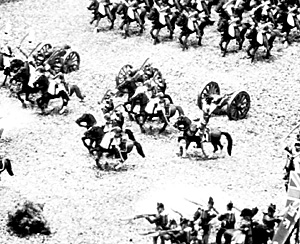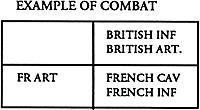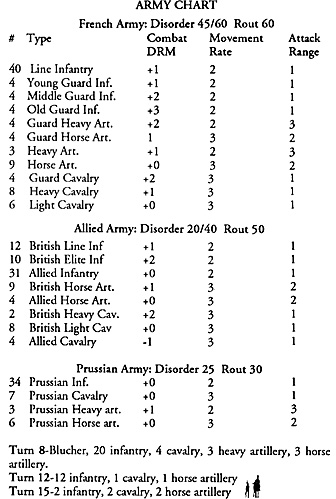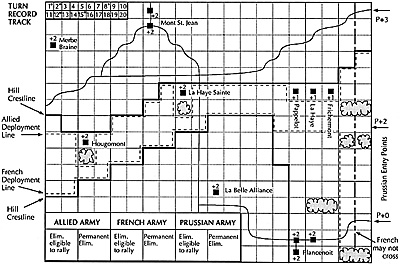 Introduction
Introduction
The Guard Dies But Does Not Surrender is a simple introductory Napoleonic miniatures wa-rgame that will allow play with a minimal investment of time and money. It can be played at any figure scale, as the size of the board squares can be varied to accomodate any figure scales. Also the number of figures used to represent the various units is of no significance.
French cavalry charging the British square at Waterloo. British gunners have taken refuge in the squares. Photo and figures by Orv Banasik.
Therefore any existing basing of figures will work. Using 15mm figures, a standard sheet of poster board 40" x 36" in an appropriate color drawn into 2" squares will be sufficient. Time, ground, and troop scales are completely abstract and are intended only to be representative of the battle. The only artillery formations that are depicted are the reserve type units, heavy and horse artillery. All orders are assumed to be factored into the other unit types, hence the ability of infantry and cavalry to defeat enemy artillery at long range.
SEQUENCE OF PLAY
1. French player turn
A. Rally Phase
B. Movement
C. Combat
2. Allied and Prussian Player turn
A. Rally Phase
B. Movement
C. Combat
STACKING
Each square may contain up to a maximum of 2 units. Only one of these may be an artillery unit.
ZONES OF CONTROL
Units must stop when they enter a square adjacent to a square occupied by an enemy unit. Diagonals are not adjacent. Units may not move from a zone of control to another zone of control.
RALLY PHASE
In the rally phase, each commander may attempt to rally an eliminated unit. Two units of the same basic type (i.e. infantry, cavalry, artillery) must be in the eliminated, eligible to rally box for a rally attempt to be made. On a roll of 4-6, one of the two units may be returnedto play and is placed with the commander. If the two units are not identical, the opponent may choose which returns. The other unit is moved to the permanently eliminated box and is now out of the game for good. Failure to rally yields no penalty. A demoralized army applies a -1 DR-M to all rally attempts. Napoleon applies a +2 DRM. The French have 2 commanders, Napoleon and Ney, while the Allied and Prussian armies each have only one, Wellington and Blucher respectively. Wellington receives a +1 DRM when rallying British (only) units. Napoleon and Wellington may each attempt two rallies in one turn if they forfeit their ability to move that turn. Commanders may move 4 squares and are not subject to elimination unless completely surrounded and unable to retreat. If an enemy desires to enter the square containing an enemy commander who is alone, the commander must retreat one square towards his friendly side.
MOVEMENT
Except for retreats, movement is only allowed in a friendly movement phase. Artillery and cavalry may not enter a woods or building square. Units that begin a movement phase in a zone of control may exit that zone of control, but if it does so it may not enter another zone of control in that same movement phase. Otherwise such units are frozen except for retreats during combat. No diagonal movement is allowed. Movement allowances are given on the army charts.
COMBAT
Attacking is completely voluntary subject to the discretion of the player whose phase is. Once an attack is made, the attacker may continue attacking as long as desired. The procedure for making an attack are as follows:
- A. Choose an area to attack from and an area to attack.
B. Designate which unit is attacking.
C. Defender designates which unit is defending.
D. Both players roll a D6 and compare modified rolls.
Various DRM apply to combat die rolls. Modified die rolls may not exceed 6 nor be less than 1. The differential between the 2 modified die rolls determines the result as fisted.
TIE ROLLS-both units take a HIT and have the option to recreate Defender first.
1-2 DIFFERENTIAL-The loser takes a HIT and must retreat.
3+ DIFFERENTI.AL-The loser unit is eliminated.
Units eliminated are placed in the eligible to rally box for eliminated units. When units have received a cumulative 2nd HIT they are also eliminated. Artillery attacking at a range of 2 or 3 versus non artillery units may halve the results of any unfavorable differential (round fractions down). If after halving, the result is a TIE, the artillery may retreat in lieu of taking the HIT. This option only applies when artillery is attacking non adjacent non artillery units.
Units that retreat move back toward their friendly side on square. Units may not retreat into a zone of control or in violation of stacking. A unit may retreat 2 squares to avoid elimination for overstacking. They are eliminated instead. Artillery may in these cases elect to take the HIT in lieu of retreat to avoid elimination.
If a defending square is totally vacated during combat, the attacker may advance into the defending square with any or all units in the attacking square unless still in the zone of control of other enemy units. Advancing after combat however precludes such units from additional attacks this turn except for cavalry who may continue to attack as an exploitation type move.
- COMBAT DRM
Attacking uphill across a hill crest (NA to artillery firing from a hill crest hex) -1
Unit in a building +1 or +2
Unit type varies-see army chart
Artillery fire at non adjacent targets may not have a square containing a woods or building intervening between the firer and target. In addition fire may not be made through a hill crest unless either of both the firer and its target is in such hill crest square.
EXAMPLE OF COMBAT
 It is the French player turn. The French player decides to attack from the square with the French artillery unit versus the British square. The French artillery unit is a Guard Heavy artillery unit. The British player elects to defend with his artillery unit. The British player rolls a 3 which is modified to 4 (+1 for British artillery), while the French player rolls a 4 which is modified to a 6 (+2 for Guard Heavy artillery). The differential is a 2. Therefore the British artillery unit must take a hit and retreat out of the square. The French elect to attack the square again with the artillery unit.
It is the French player turn. The French player decides to attack from the square with the French artillery unit versus the British square. The French artillery unit is a Guard Heavy artillery unit. The British player elects to defend with his artillery unit. The British player rolls a 3 which is modified to 4 (+1 for British artillery), while the French player rolls a 4 which is modified to a 6 (+2 for Guard Heavy artillery). The differential is a 2. Therefore the British artillery unit must take a hit and retreat out of the square. The French elect to attack the square again with the artillery unit.
The British must defend with the British infantry unit and rolls a 4 which is modified to 5. The French rolls a I which is modified to a 3. The differential is a 2 in favor of the British. However, since it involved artillery at long range versus a non artillery unit, the differential is halved and the diffence is now a 1. The artillery unit elects to retreat in lieu of taking the HIT. The French now decides to attack with his adjacent infantry unit. The French player rolls a 2 which is modified to a 3. The British player rolls a 2 also, which also yields a 3. As the result is a tie, both units take a HIT and the British player elects to retreat. The French player now has the option to advance with both the Infantry and cavalry unit into the now vacant square. If he does so he may not continue to attack with the infantry unit but may do so with the cavalry.
THE PRUSSIANS
The Prussian army under Blucher becomes available on the indicated turn numbers. Each group of Prussians must designate one of the 3 possible entry points on the turn they are available. A die roll is then made to determine whether they may arrive that turn. A roll of 1-4 is needed to arrive. Apply the entry point DRM (0,+2,or +3) as indicated. For each turn delayed apply a -1 DRM to future rolls. Example, the turn 8 reinforcements (Blucher, 20 infantry, 4 light cavalry, 3 heavy artillery, 3 horse artillery) can enter using the 0 DRM entry point with a DR of 1-4 on turn 8, a 1-5 on turn 9 etc. until a successfull roll is made.
Units may then enter on or adjacent to the entry point. On following turns they may also enter up to 2 squares of either side of the entry point. Prussian units (only) may retreat off the board during combat and then reenter in the following turn.
 ARMY MORALE
ARMY MORALE
At any point that an army has a certain number or more units eliminated (either available for rally or permanently), it will reach disorder or rout levels as specified on the army chart. For example, when the French have 45 or more units eliminated, they become disordered. Disordered armies receive a -1 DRM for all attacks (defends normally) and rally rolls as long as the army is disordered (units may rally and bring the number back below the disorder number). The French and Allied Armies have 2 disorder numbers. For the French, the first number applies to all non Guard units while the second applies also to the Guard.
Therefore, the French Guard will continue to fight on at full effect even though the rest of the army is in disorder. As the Guard does not disorder until the army routs, they will in effect never disorder (They die but do not surrender). The Allied Army disorder numbers are for non British units and British units respectively. Non British units become disordered when the army has 20 or more units eliminated, while the British portion of the army does not disorder until the total reaches 40. For disorder and rout purposes, French old and middle guard infantry count as 2 units eliminated for each actual one eliminated.
When an army reaches rout level, it is instantly defeated. Remaining units are removed from the board.
VICTORY
The French army wins by defeating the Allied Army within 20 game turns. Any other result is a Prussian-Allied victory. If the French army routs, it is also a decisive victory bringing an end to the war and the final downfall of Napoleon. If the Prussian army is routed, but the French fA to rout the allies the French achieve a minor tacticall victory but achieve a strategic setback. If for any reason the Napoleon figure is eliminated the French suffer an automatic defeat.
MUD
On turns one and two, all movement allowances are reduced by I and all artillery receives an additional -1 DRM when attacking or defending at a range greater than 1.
NOTES
The playing surface that I use is a green colored standard poster board ruled off into 2" squares. Roads and crest lines can be drawn with magic markers. More realistically, crests can be represented with an additional layer of poster board superimposed over the base level cut out matching the higher ground. Woods and buildings can also be drawn on the board or can be represented with appropriate models.
Units can be represented with either individual figures appropriately painted to represent the troop type. Alternatively they may be represented with bases of figures used in other Napoleonic miniatures rules systems. Regardless how many figures are on a base, each base represents one unit.

Back to Table of Contents -- Courier # 61
To Courier List of Issues
To MagWeb Master Magazine List
© Copyright 1993 by The Courier Publishing Company.
This article appears in MagWeb.com (Magazine Web) on the Internet World Wide Web.
Other articles from military history and related magazines are available at http://www.magweb.com